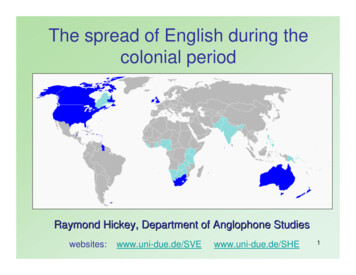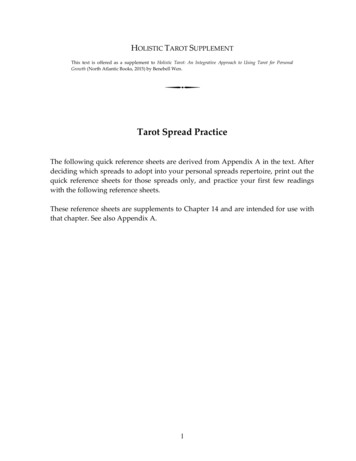
Transcription
The spread of English during thecolonial periodRaymond Hickey, Department of Anglophone HE1
The anglophone world todayDark blue regions: English as first languageLight blue regions: English as second language2
A New and Accurate Map of the World (1627) by theEnglish cartographer John Speed3
The colonial world in the late 18th century4
The colonial world in the late 19th century5
6
Two halves of the anglophone world7
Some major differencesThe northern hemisphere was settled first (after 1600)while the southern hemisphere was settled much later(after 1800). This means that forms of English there arecloser to English in south-east England today, e.g. in nothaving syllable-final /-r/ in words like car or card.Other major differences between the two hemispheresinvolve the pronunciation of vowels, e.g. the short frontvowels (as in bad, bed, bid) have a raised pronunciationwhereas the long vowels and diphthongs (as in tape,time, toy, taught) tend to be lowered and/or retracted.8
Main blocks of the anglophone world9
‘New Englishes’Second languagevarieties of English10
Scenarios for the English language overseasSeveral factors are responsible for the types of English which havearisen outside Europe during the colonial period, roughly from the early17th to the late 19th century. Early settlers went to the New World, firstto the Caribbean then to eastern Canada and the later United States(to form the original 13 colonies). Some people left the British Isles oftheir own free will, some were forcibly deported, some served asindentured labourers.At the new locations, settlers sometimes mixed with indigenouspeoples, with other settlers or with slaves from Africa. This mixture hadan effect on the forms of English which arose at the new locations.11
The Caribbean Sea with its islands12
Main periods in the history of the Caribbean Pre-Columbian Period(before 1492) The Spanish Period(after 1492) British Involvement(from the early 1600s onwards)13
Source and destination of slave transportation14
The Trade Triangle15
English in the Caribbean areaThe first Carribean islands to be settled by the British were St Kitts(1623/4) in the north-east and Barbados (1627) in the south-eastcorner of the Caribbean Basin. When this island filled up, Englishspeakers left for other locations, especially for Jamaica after it wastaken by the British in 1660.Initially, the Carribean was populated by whites, during the so-called‘Homestead Phase’, later by blacks taken from West Africa as slavesand transported across the Atlantic along the infamous MiddlePassage.Many other smaller islands were populated by English-speakers andmany changed hands between the colonial maritime powers, namelyEngland, France, Spain, Portugal and the Netherlands. Most of theseislands gain their independence in the mid 20th century.In the late 17th century a number of Caribbean slaves were transportedto the south-east of the United States to work on the large cottonplantations. Later slaves were transported directly. The system ofslavery lasted until the end of the American Civil War (1860-65).16
Major English-speaking Caribbean islandsJamaicaBarbados17
Anglophone locations in the Caribbean18
Emigration to the United StatesDuring the 18th century upwards of a quarter of a million Scots andUlster Scots emigrated to the east of America. They settled in statesalong the coast from Pennsylvania down to South Carolina. Many ofthem also settled in the Appalachian mountains and the speech ofthis region shows many traces of Scots input to this day.Later in the 19th century many millions fled Ireland as a result of famine(e.g. the Great Famine of 1845-8). These largely Catholic emigrantssettled in the cities of the north-eastern United States, such as NewYork and Boston. Because they were considerably later than theScots their speech did not have a comparable effect on AmericanEnglish, though locally there are traces of this Irish English input.19
20
Note the concentration of dialect differences in theeastern United States which is due to the diversenature of early emigration to this area.21
The Southern HemisphereThe anglophone southern hemisphere consists primarily ofSouth Africa, Australia and New Zealand. These arecountries where ‘settler English’ continues.Irish input to South Africa was minimal but quite significantin Australia where many Irish were deported in the earlydays of the country as a penal colony (in the later fewdecades of the 18th and the beginning of the 19thcenturies). Later there was normal emigration toAustralia and to New Zealand where mass emigrationbegan after the treaty of Waitangi between the Britishand the local Maori in 1840.22
The early anglophone settlement of South Africa23
The transportation of speakers from India to Natal24
Transportation to Australia / New Zealand25
Australia and New ZealandBoth Australia (1788 - ) and New Zealand (1840 - ) had mostly Englishinput with some Scottish and considerable Irish input (between 25% and30% of the original settlers). However, their speech was not continuedat either location, probably because of the dominance of English speechmodels, given that both countries were colonies of Britain. TodayAustralian and New Zeland English sound like southern British English.26
Literature on Varieties of English27
Literature on Varieties of English28
Conventional histories of English29
More inclusive overviews of English30
Literature on the spread of English31
Literature on World Englishes32
closer to English in south-east England today, e.g. in not having syllable-final /-r/ in words like car or card. Other major differences between the two hemispheres involve the pronunciation of vowels, e.g. the short front vowels (as in bad, bed, bid) have a raised pronunciation whereas the long vowels and diphthongs (as in tape, time, toy, taught) tend to be lowered and/or retracted. 9 Main .










